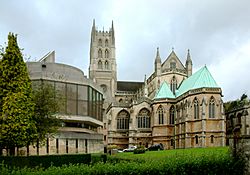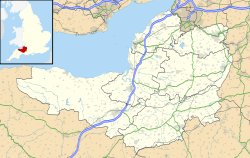Downside Abbey facts for kids

Abbey monastic basilica and library (left)
|
|
| Monastery information | |
|---|---|
| Full name | Abbey of St Gregory the Great at Downside |
| Order | Benedictine |
| Denomination | Roman Catholicism |
| Established | 1606 |
| Mother house | Valladolid |
| Dedicated to | Gregory the Great |
| Diocese | Clifton |
| Controlled churches | St Benedict's Church, Stratton-on-the-Fosse Church of the Holy Ghost, Midsomer Norton St Francis Xavier's Church, Hereford |
| People | |
| Founder(s) | St John Roberts OSB |
| Abbot | Dom Nicholas Wetz OSB |
| Prior | Dom Anselm Brumwell OSB |
| Important associated figures | Architects Archibald Matthias Dunn and Edward Joseph Hansom, Cardinal Gasquet, Ambrose Barlow |
| Architecture | |
| Style | Gothic Revival |
| Completion date | 1935 |
| Site | |
| Location | Belmont Abbey, Hereford, Herefordshire, England (until 13 March 2022 – Stratton-on-the-Fosse, Somerset, England) |
| Coordinates | 51°15′20″N 2°29′43″W / 51.2556°N 2.4954°W |
| Grid reference | ST655508 |
| Other information | Relics of St. Oliver Plunkett and St. Thomas de Cantilupe |
Downside Abbey was a Benedictine monastery in England. It is the oldest community of the English Benedictine Congregation. For many years, the abbey was closely connected to Downside School, which educated students aged 11 to 18. Both the abbey and the school were located in Stratton-on-the-Fosse, in Somerset, South West England.
In 2020, there were 15 monks living at Downside Abbey. The community moved from the abbey in 2022. They first went to Devon and then, in July 2025, they moved to Belmont Abbey, Herefordshire.
The Abbey Church of St Gregory the Great was started in 1873 but was never fully finished. It is a very important historic building, listed as Grade I listed. Its Gothic Revival architecture style was described as a "splendid demonstration" of the return of Roman Catholicism in England. The monastic buildings at Downside are mostly empty now.
Contents
History of Downside Abbey
How the Abbey Started and Grew
The community began in 1607 in Douai, which was then part of the Spanish Netherlands. It was named after St Gregory the Great. The founder was a Welshman named St John Roberts. He became the first leader, called a prior. He started the new community with other English monks who had joined different monasteries.
The Priory of St Gregory was the first English Benedictine house to restart monastic life after the English Reformation. For almost 200 years, the monastery trained monks to serve in England. Six of these monks were later declared "blessed" by Pope Pius XI in 1929. Two of them, Saints John Roberts and Ambrose Barlow, were among the Forty Martyrs of England and Wales. They were made saints by Pope Paul VI in 1970.
During the French Revolution, French soldiers took over Flanders. The monks were forced to leave their monastery after being held prisoner. In March 1795, they were allowed to go to England. They stayed for about 20 years with Sir Edward Smythe in Acton Burnell, Shropshire. Finally, in 1814, they settled at a manor house called Mount Pleasant in Downside, Somerset.
The monastery buildings were finished in 1876. Downside became an Abbey in 1899. Prior Edmund Ford was chosen as the first Abbot in 1900.
Changes in the 21st Century
Between 2018 and 2020, the abbey faced financial difficulties. This led to the sale of some valuable items, including old paintings.
In September 2018, Dom Nicholas Wetz from Belmont Abbey was appointed to manage Downside Abbey for two years. In August 2020, he was elected as the first Abbot of Downside Abbey in six years. At the same time, it was announced that the monks would look for a new home. This was because the current building was too large for their smaller number of monks. In 2020, there were 15 monks.
In the spring of 2022, the community moved to a temporary home called "Southgate House" near Buckfast Abbey in Devon. They continued to live there as the Community of St Gregory the Great.
This move left the large monastery building empty. It used to house about 50 monks. By 2025, Downside School had changed the old dining hall into a new center for older students.
In March 2025, it was announced that the Community of St Gregory the Great would move to Belmont Abbey, Herefordshire. This move happened in July 2025. The two Benedictine communities live together but remain separate for now.
The Abbey Church
| Downside Abbey | |
|---|---|
| Minor basilica and abbey church of St Gregory the Great | |

A view of the monastic church
|
|
| Location | Stratton-on-the-Fosse, Shepton Mallet, Somerset |
| Country | England |
| Denomination | Roman Catholic |
| Tradition | Roman Rite |
| History | |
| Status | Minor basilica |
| Founded | 1814 |
| Consecrated | 1935 |
| Relics held | Oliver Plunkett Thomas de Cantilupe |
| Architecture | |
| Functional status | Used as a chapel by Downside School |
| Architect(s) | Archibald Matthias Dunn, Edward Joseph Hansom, Thomas Garner |
| Style | Gothic Revival |
| Years built | 1873–1925 |
| Completed | 1925 |
| Administration | |
| Archdiocese | Birmingham |
| Metropolis | Birmingham |
| Diocese | Clifton |
| Province | Birmingham |
Building the Church
The construction of Downside Abbey church started in 1873. The first parts built were the transepts (the arms of the cross-shaped church) and the Lady Chapel. The first stone was laid on October 1, 1873. Important church leaders, including Archbishop Manning, were there for the ceremony.
The architects for the new building were Messrs. Dunn and Edward Joseph Hansom. They designed it in a medieval Gothic style. The church was planned to be very grand, with a tall tower and spire. The stone used for building came from nearby Doulting Stone Quarry. This same stone was used for famous buildings like Wells Cathedral and Glastonbury Abbey.
In 1925, the unfinished main part of the church (the nave) was dedicated. This was done to honor the former students of the school who died in World War I.
When the Church Became a Basilica
The abbey church was officially consecrated (made sacred) in 1935. At the same time, Pope Pius XI gave it the special title of a minor basilica. This was the first church in England to receive this honor.
The consecration ceremony was a very grand event. Many important church leaders attended, including cardinals, archbishops, bishops, and abbots. Over 500 priests were also there.
Special Features of the Church
The church holds the relics of St. Oliver Plunkett. He was an archbishop from Ireland who was executed in 1681. His body was given to a Benedictine monk for care.
Downside Abbey church is one of only four churches in the United Kingdom to be called a minor basilica by the Roman Catholic Church.
The church is built in the Gothic Revival style, using Bath stone. It was designed to be as large as the medieval cathedrals in England that were lost during the English Reformation. The oldest parts, the transepts, date from 1882. The choir section was finished in 1905. The main part of the church (the nave) was designed around 1923–25 but is still unfinished.
The Lady chapel is known for its beautiful design by Sir Ninian Comper. It has a special screen behind the altar (a reredos) and altar decorations that include old pieces. It also holds a reliquary with the skull of St Thomas de Cantilupe. The church's tower, completed in 1938, is 166 feet (55 meters) tall. This makes it the second highest in Somerset.
The church building, along with part of the cloister (a covered walkway), was given a Grade I listing in 1986. This means it is a building of exceptional historical and architectural interest.
The Organs of the Abbey Church
The abbey church has had several organs over the years.
The first pipe organ was built in 1805. It was originally in the Music Room of Brighton Pavilion. In 1882, it was moved to the new church at Downside. This organ was later moved to a nearby parish church in 1907.
A new organ was planned for 1905, but it was never fully completed.
The current organ in the abbey church was built in 1931 by John Compton. It is a very large instrument with 142 different sounds (speaking stops). These sounds come from 38 sets of pipes. The organ is hidden inside stone and concrete rooms. The outside of the organ, designed by Giles Gilbert Scott, is made of solid oak and has no visible pipes. The organ's control panel (console) is made from wood from the ship HMS Bellerophon. This ship carried Napoleon after the Battle of Waterloo.
The Monastery Buildings
An early building on the site was a small lodge at the east entrance, built in 1827. The main monastery and its attached cloisters were finished in 1873. The architects were A. M. Dunn and E. J. Hansom. They used Bath stone and red tiles, in a style called "High Victorian Gothic."
The monastery building has three floors, and four floors at its south end. The main entrance is under a tall, octagonal tower. The east side of the building is hidden by the library, which was built in 1971. A new wing was added in 1975, providing a dining hall and guest rooms.
The monastery, including a cloister that connects it to the school, was given a Grade II* listing in 1986. This means it is a particularly important building. The 1975 east wing was added to this listing in 2024.
The Abbey Library
The Monastery's library has a huge collection of about 450,000 books, old printed books (called incunabula), manuscripts, and magazines. It also holds the historical records of the English Benedictine Congregation. The collection of medieval manuscripts is considered "the most important in the South West of England."
The books are kept in a six-story octagonal building. It was designed in the 1960s style by Francis Pollen and finished in 1971. In 2024, the library was given a Grade II listing. It was described as a "highly imaginative building" with excellent craftsmanship.
In 2013, the library received a large grant of £856,000. This allowed the historical records to be opened to the public. Many of the rare books and manuscripts were also made available digitally. The grant also helped to repair and improve the library building.
In March 2017, it was reported that the Abbey would publish a copy of a Georgian recipe book from 1793. This book was found in the library in 2016. It included one of the earliest known UK recipes for curry. It also described daily life at Begbrook House near Bristol.
The Abbey Cemetery
The Abbey Cemetery is mainly a burial ground for the monks. It also contains two war graves from World War II. These are for a Lieutenant from the Duke of Cornwall's Light Infantry and a Sub-Lieutenant from the Royal New Zealand Navy. Other people buried here include Mrs. Baron Charles von Hügel and two of her children, Friedrich and Pauline.
Leaders of the Abbey
Here are some of the people who have led Downside Abbey:
- John Bede Polding (1805–19)
- Prior/Abbot Edmund Ford (1894–1906)
- Abbot Cuthbert Butler (1906–22)
- Abbot Leander Ramsay (1922–29)
- Abbot John Chapman (1929–33)
- Abbot Bruno Hicks (1933–38)
- Abbot Sigebert Trafford (1938–46)
- Abbot (later Bishop) Christopher Butler (1946–66)
- Abbot Wilfrid Passmore (1966–74)
- Abbot John Roberts (1974–90)
- Abbot Charles Fitzgerald-Lombard (1990–98)
- Abbot Richard Yeo (1998–2006)
- Abbot Aidan Bellenger (2006–14)
- Prior Administrator Leo Maidlow Davis (2014–18)
- Prior/Abbot Nicholas Wetz (Prior Administrator 2018–20, Abbot 2020–)
Famous Monks
Many notable monks have been part of Downside Abbey, including:
- Dom Christopher Butler OSB, an abbot, bishop, and scholar.
- Dom Richard Connolly (1873–1948), a scholar of Syriac language.
- Cardinal Dom Francis Aidan Gasquet OSB, a Vatican librarian and historian.
- Dom David Knowles OSB, a professor at Cambridge and historian of monasteries.
- Dom Gregory Murray OSB (1905-92), a composer, church music expert, and organist.
- Dom William Bernard Ullathorne OSB, a bishop and theologian.
- Dom Roger Vaughan OSB, who became the second Roman Catholic Archbishop of Sydney, Australia.
Downside School
Downside School was connected to the monastery until 2019. It is a public school for boys and girls aged 11 to 18. Like most Roman Catholic schools today, it accepts students who are not Catholic.
In the 1800s, Downside was a small school run by the monks. Dom Leander Ramsay helped create the modern Downside School. He planned the new buildings that opened in 1912.
The school has a board of governors with eleven members. One of these members is from the Abbey community.
Since September 2019, the school and the abbey are managed by separate organizations. This change was made as part of reforms to their management.
External Links
- Archives and Library catalogue
- Downside on the website of the English Benedictine Congregation
- Downside Abbey in the Catholic Encyclopaedia
See also
 In Spanish: Abadía de Downside para niños
In Spanish: Abadía de Downside para niños




